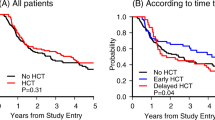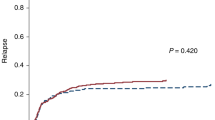Abstract
The factors that influence utilization of reduced-intensity conditioning (RIC) allogeneic hematopoietic stem cell transplantation (HCT) among medically fit older patients with advanced myelodysplastic syndromes (MDS) are largely unknown. The MDS Transplant-Associated Outcomes (MDS-TAO) study is an ongoing prospective observational study at the Dana-Farber Cancer Institute and Massachusetts General Hospital that enrolls transplant-eligible fit patients aged 60–75 years with advanced MDS and follows them through RIC HCT vs non-HCT treatment. In this analysis of 127 patients enrolled from May 2011 to June 2014, we examined the influence of age, gender, cytogenetics, International Prognostic Scoring System (IPSS) category, performance status, distance from HCT center and baseline patient-reported quality of life (QOL) from the EORTC QLQ-C30 (European Organization for Research and Treatment of Cancer Quality of Life Questionnaire) on the likelihood of receiving RIC HCT using competing risk regression modeling. With a median follow-up of 16 months, 44 patients (35%) had undergone RIC HCT. In multivariable analyses, age (hazard ratio (HR) 0.87 per year, 95% confidence interval (CI): 0.81–0.92, P<0.001) and higher IPSS (intermediate-2/high; HR 2.29, 95% CI: 1.25–4.19, P=0.007) were significantly predictive of receipt of RIC HCT; neither global QOL score nor any QOL subscales scores were predictive. These data suggest that baseline patient-reported QOL has little influence on the decision to undergo RIC HCT for older patients with advanced MDS.
This is a preview of subscription content, access via your institution
Access options
Subscribe to this journal
Receive 12 print issues and online access
$259.00 per year
only $21.58 per issue
Buy this article
- Purchase on Springer Link
- Instant access to full article PDF
Prices may be subject to local taxes which are calculated during checkout


Similar content being viewed by others
References
Steensma DP, Bennett JM . The myelodysplastic syndromes: diagnosis and treatment. Mayo Clin Proc 2006; 81: 104–130.
Hofmann WK, Koeffler HP . Myelodysplastic syndrome. Annu Rev Med 2005; 56: 1–16.
Greenberg P, Cox C, LeBeau MM, Fenaux P, Morel P, Sanz G et al. International scoring system for evaluating prognosis in myelodysplastic syndromes. Blood 1997; 89: 2079–2088.
Steensma DP, Heptinstall KV, Johnson VM, Novotny PJ, Sloan JA, Camoriano JK et al. Common troublesome symptoms and their impact on quality of life in patients with myelodysplastic syndromes (MDS): results of a large Internet-based survey. Leuk Res 2008; 32: 691–698.
Thomas ML . Quality of life and psychosocial adjustment in patients with myelodysplastic syndromes. Leuk Res 1998; 22: S41–S47.
Jansen AJ, Essink-Bot ML, Beckers EA, Hop WC, Schipperus MR, Van Rhenen DJ . Quality of life measurement in patients with transfusion-dependent myelodysplastic syndromes. Br J Haematol 2003; 121: 270–274.
Lucioni C, Finelli C, Mazzi S, Oliva EN . Costs and quality of life in patients with myelodysplastic syndromes. Am J Blood Res 2013; 3: 246–259.
Martino R, Valcarcel D, Brunet S, Sureda A, Sierra J . Comparable non-relapse mortality and survival after HLA-identical sibling blood stem cell transplantation with reduced or conventional-intensity preparative regimens for high-risk myelodysplasia or acute myeloid leukemia in first remission. Bone Marrow Transplant 2008; 41: 33–38.
Chang C, Storer BE, Scott BL, Bryant EM, Shulman HM, Flowers ME et al. Hematopoietic cell transplantation in patients with myelodysplastic syndrome or acute myeloid leukemia arising from myelodysplastic syndrome: similar outcomes in patients with de novo disease and disease following prior therapy or antecedent hematologic disorders. Blood 2007; 110: 1379–1387.
Laport GG, Sandmaier BM, Storer BE, Scott BL, Stuart MJ, Lange T et al. Reduced-intensity conditioning followed by allogeneic hematopoietic cell transplantation for adult patients with myelodysplastic syndrome and myeloproliferative disorders. Biol Blood Marrow Transplant 2008; 14: 246–255.
Deeg HJ . Transplant strategies for patients with myelodysplastic syndromes. Curr Opin Hematol 2006; 13: 61–66.
Deeg HJ . Optimization of transplant regimens for patients with myelodysplastic syndrome (MDS). Hematology Am Soc Hematol Educ Program 2005, 167–173.
Kroger N, Shimoni A, Zabelina T, Schieder H, Panse J, Ayuk F et al. Reduced-toxicity conditioning with treosulfan, fludarabine and ATG as preparative regimen for allogeneic stem cell transplantation (alloSCT) in elderly patients with secondary acute myeloid leukemia (sAML) or myelodysplastic syndrome (MDS). Bone Marrow Transplant 2006; 37: 339–344.
Alyea EP, Kim HT, Ho V, Cutler C, DeAngelo DJ, Stone R et al. Impact of conditioning regimen intensity on outcome of allogeneic hematopoietic cell transplantation for advanced acute myelogenous leukemia and myelodysplastic syndrome. Biol Blood Marrow Transplant 2006; 12: 1047–1055.
Alyea EP, Kim HT, Ho V, Cutler C, Gribben J, DeAngelo DJ et al. Comparative outcome of nonmyeloablative and myeloablative allogeneic hematopoietic cell transplantation for patients older than 50 years of age. Blood 2005; 105: 1810–1814.
Koreth J, Pidala J, Perez WS, Deeg HJ, Garcia-Manero G, Malcovati L et al. Role of reduced-intensity conditioning allogeneic hematopoietic stem-cell transplantation in older patients with de novo myelodysplastic syndromes: an international collaborative decision analysis. J Clin Oncol 2013; 31: 2662–2670.
Smith AR, Warlick ED, Roesler MA, Poynter JN, Richardson M, Nguyen P et al. Factors associated with hematopoietic cell transplantation (HCT) among patients in a population-based study of myelodysplastic syndrome (MDS) in Minnesota. Ann Hematol 2015; 94: 1667–1675.
Pinchon DJ, Stanworth SJ, Doree C, Brunskill S, Norfolk DR . Quality of life and use of red cell transfusion in patients with myelodysplastic syndromes. A systematic review. Am J Hematol 2009; 84: 671–677.
Cleeland CS, Williams LA . Symptom burden in hematologic malignancies. Blood 2014; 123: 3686–3687.
Wood WA, Le-Rademacher J, Fei M, Logan BR, Syrjala KL, Majhail NS et al. Patient-reported quality of life is an independent predictor of survival after allogeneic hematopoietic cell transplantation: a secondary analysis from the Blood and Marrow Transplant Clinical Trials Network (BMT CTN) 0902. Abstract Presented at ASH 2014, 2014.
Hamilton BKR, Abounder L, Dabney DM, Dean J, Duong RM, Hill HK et al. Prognostic significane of quality of life in patients undergoing allogeneic hematopoietic cell transplantation. Abstract Presented at ASH 2014, 2014.
Deschler B, Ihorst G, Platzbecker U, Germing U, Marz E, de Figuerido M et al. Parameters detected by geriatric and quality of life assessment in 195 older patients with myelodysplastic syndromes and acute myeloid leukemia are highly predictive for outcome. Haematologica 2013; 98: 208–216.
Abel GA, Koreth J . Optimal positioning of hematopoietic stem cell transplantation for older patients with myelodysplastic syndromes. Curr Opin Hematol 2013; 20: 150–156.
Malcovati L, Germing U, Kuendgen A, Della Porta MG, Pascutto C, Invernizzi R et al. Time-dependent prognostic scoring system for predicting survival and leukemic evolution in myelodysplastic syndromes. J Clin Oncol 2007; 25: 3503–3510.
Haase D, Germing U, Schanz J, Pfeilstocker M, Nosslinger T, Hildebrandt B et al. New insights into the prognostic impact of the karyotype in MDS and correlation with subtypes: evidence from a core dataset of 2124 patients. Blood 2007; 110: 4385–4395.
Aaronson NK, Ahmedzai S, Bergman B, Bullinger M, Cull A, Duez NJ et al. The European Organization for Research and Treatment of Cancer QLQ-C30: a quality-of-life instrument for use in international clinical trials in oncology. J Natl Cancer Inst 1993; 85: 365–376.
Lubbert M, Suciu S, Baila L, Ruter BH, Platzbecker U, Giagounidis A et al. Low-dose decitabine versus best supportive care in elderly patients with intermediate- or high-risk myelodysplastic syndrome (MDS) ineligible for intensive chemotherapy: final results of the randomized phase III study of the European Organisation for Research and Treatment of Cancer Leukemia Group and the German MDS Study Group. J Clin Oncol 2011; 29: 1987–1996.
Fine JP, Gray RJ . A proportional hazards model for the subdistribution of competing risk. J Am Stat Assoc 1999; 94: 496–509.
El-Jawahri A, Traeger L, Park ER, Greer JA, Pirl WF, Lennes IT et al. Association among prognostic understanding, quality of life, and mood in patients with advanced cancer. Cancer 2014; 120: 278–285.
Mack JW, Weeks JC, Wright AA, Block SD, Prigerson HG . End-of-life discussions, goal attainment, and distress at the end of life: predictors and outcomes of receipt of care consistent with preferences. J Clin Oncol 2010; 28: 1203–1208.
Sekeres MA, Maciejewski JP, List AF, Steensma DP, Artz A, Swern AS et al. Perceptions of disease state, treatment outcomes, and prognosis among patients with myelodysplastic syndromes: results from an Internet-based survey. Oncologist 2011; 16: 904–911.
Steensma DP, Komrokji RS, Stone RM, List AF, Garcia-Manero G, Huber JM et al. Disparity in perceptions of disease characteristics, treatment effectiveness, and factors influencing treatment adherence between physicians and patients with myelodysplastic syndromes. Cancer 2014; 120: 1670–1676.
Efficace F, Gaidano G, Sprangers M, Cottone F, Breccia M, Voso MT et al. Preference for involvement in treatment decisions and request for prognostic information in newly diagnosed patients with higher-risk myelodysplastic syndromes. Ann Oncol 2014; 25: 447–454.
Sekeres MA, Stone RM, Zahrieh D, Neuberg D, Morrison V, De Angelo DJ et al. Decision-making and quality of life in older adults with acute myeloid leukemia or advanced myelodysplastic syndrome. Leukemia 2004; 18: 809–816.
Oliva EN, Finelli C, Santini V, Poloni A, Liso V, Cilloni D et al. Quality of life and physicians' perception in myelodysplastic syndromes. Am J Blood Res 2012; 2: 136–147.
Klepin HD, Rao AV, Pardee TS . Acute myeloid leukemia and myelodysplastic syndromes in older adults. J Clin Oncol 2014; 32: 2541–2552.
Abel GA, Klaassen R, Lee SJ, Young NL, Cannella L, Steensma DP et al. Patient-reported outcomes for the myelodysplastic syndromes: a new MDS-specific measure of quality of life. Blood 2014; 123: 451–452.
Acknowledgements
This work was supported by National Palliative Care Research Center Career Development Award (to AEJ) and Leukemia and Lymphoma Society Research Scholar Grant (to GAA).
Author information
Authors and Affiliations
Corresponding author
Ethics declarations
Competing interests
The authors declare no conflict of interest.
Rights and permissions
About this article
Cite this article
El-Jawahri, A., Kim, H., Steensma, D. et al. Does quality of life impact the decision to pursue stem cell transplantation for elderly patients with advanced MDS?. Bone Marrow Transplant 51, 1121–1126 (2016). https://doi.org/10.1038/bmt.2016.40
Received:
Revised:
Accepted:
Published:
Issue Date:
DOI: https://doi.org/10.1038/bmt.2016.40
This article is cited by
-
Fit older adults with advanced myelodysplastic syndromes: who is most likely to benefit from transplant?
Leukemia (2021)
-
Patient-Reported Outcomes in Myelodysplastic Syndromes: the Move from Life Span to Health Span
Current Hematologic Malignancy Reports (2020)
-
Decision Analysis of Transplantation for Patients with Myelodysplasia: “Who Should We Transplant Today?”
Current Hematologic Malignancy Reports (2020)
-
Transplants for MDS and quality-of-life. But whose quality-of-life?
Bone Marrow Transplantation (2016)
-
Hematopoietic cell transplantation in MDS: undervalued and underutilized
Bone Marrow Transplantation (2016)



